18 July, 2001
View from top of the Lion's Head & Seismic reflections
6:30 a.m. (July 19)
We played and worked hard yesterday. By the time 9:30 p.m. rolled around,
virtually everyone in the camp was asleep... Thus, the late journal.
Life on the ice.. .. (almost)
The sun woke me by shining in my eyes; the clouds had disappeared and the
surroundings were spectacular. Pat related that he is sometimes very
pleasantly surprised that people pay him to travel and work in places like
this.
Yesterday afternoon, Kendra, a student of Greg's at SUNY-Buffalo, joined us
as we were leaving the glacier. She will be working (at least partly) with
us as we collect data.
Shortly after we arrived back in camp after collecting the day's data, we
piled in the van and drove the base of Lion's Head, a nearby mountain. We
hiked 1,500 feet up and had our breath taken away, not just from the steep
climb, but also the extraordinary view of the Matanuska Glacier. I've
included a couple of pictures from the top of Lion's Head at the end of this
entry.
It turns out that Lion's Head is made of intrusive igneous rock, molten rock
that squeezed through existing sedimentary rock about 15 million years ago.
The sedimentary rock that surrounded Lion's Head eroded more quickly than the
igneous rock, leaving a steep mountain rising 1,500 feet above the valley
floor. Question for especially clever readers: Where else in the
United States might you find a good example of the same thing?
Science at work
For those readers who are still a bit confused about what seismic reflection
is, I offer a couple of different ways to think about it:
(1) sonograms... When doctors take a sonogram, they direct low-power sound
waves into a woman's uterus. The "echo" they receive back gives them many
clues about the baby's health and gender.
(2) echoes... If you wanted to find the distance to a far building, all you
would need is a stop watch. By yelling quickly and starting the stop watch
at the same time, and then stopping the stop watch when you heard the echo,
you could calculate how far away the building was. "How?" you may ask. If
we know ...
(a) the speed sound travels in the air (about 330 m/s) and
(b) how long it took the sound to travel to the building and back (measured
from stop watch),
then, by multiplying the speed by the time, we can find the distance the
sound traveled.
Seismic reflections are echoes within the earth. It is more complicated than
measuring echoes in the air because the velocity of sound through the earth
can vary greatly (it travels at about 300 m/s in dry sand and 6,000 m/s in
limestone). To collect seismic data, we need a couple of different tools:
reliable way to create seismic waves, some way to measure the seismic waves
and some way to collect the data.
A sledge hammer acts as our seismic wave creator, geophones (see
below) measure the vibrations or echoes, and a seismograph collects the data.
Geophones are very cool little gadgets. A magnet is connected to spike, and
is surrounded by a coil of wires mounted on very sensitive springs. When the
ground trembles, the spike (and magnet) move, but the springs resist movement
(Newton's first law strikes again!). The result is the magnet moving up and
down relative to the wires. If you move a magnet through a coil of wires,
you create electricity (indeed, the electricity to power your computer is
generated this way... though, of course, the magnet and wires are much
bigger). The more movement, the more electricity. The seismograph measures
the amount of electricity from each geophone, and allows us to listen to
echoes from all along the line.
I've got to wrap up... We're headed to the glacier soon!
Cheers.
~SM
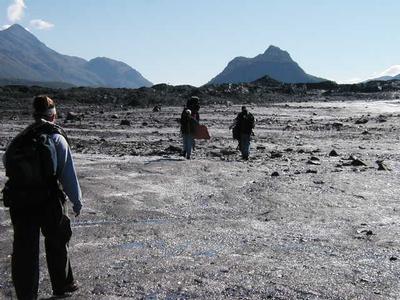
Heading to work site on glacier... The equipment is bulky and quite heavy.
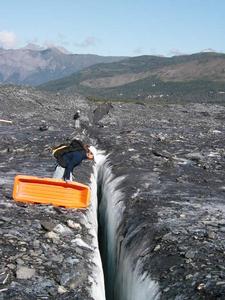
This is a creavase... The girl from yesterday is very lucky she didn't fall in here.
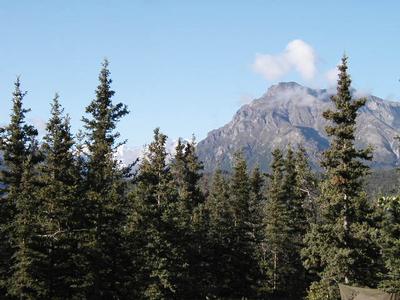
The sun rose at 6:00 a.m. It was an incredible day.
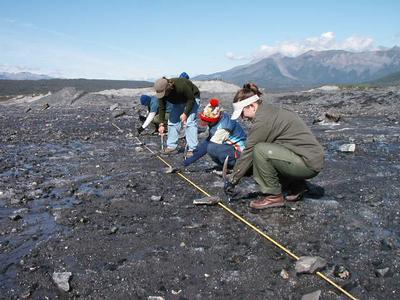
Here Andrea, Ranae and Sean are pounding holes in the ice for geophones. Jeff is inserting geophones into holes.
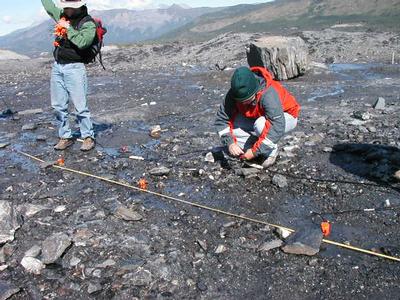
Mehgan is connected geophones to the take-out cord.
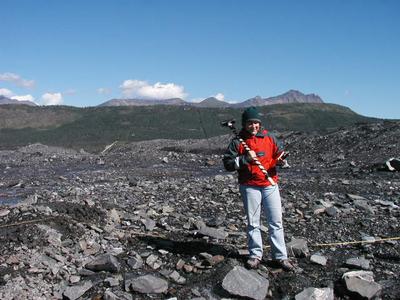
The geophones are set up and connected to the seismograph. Mehgan holds the seismic hammer of science in one hand and a walkie-talkie in the other, ready to start creating seismic waves.

The team is hard at work. Pat and Sean are creating seismic waves; Nelson, Ranae and Greg are reading the data

Sean and I are waiting for data collector to give the "Go" signal

Greg is using the seismic hammer of science to create seismic reflections. Sean is holding the aluminum plate in place with his feet!

When we climbed Lion's Head yesterday, we had an extraordinary view of the Matanuska Glacier. For scale, the big mountain in the foreground rises 6,000 feet over the glacier, and the glacier stretches back for almost 20 miles.... Breathtaking!

Most of the group hiked to the top of Lion's Head... Here we are
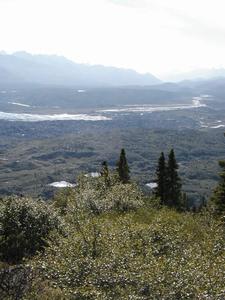
Just off the peak of Lion's Head, we had a great view of the terminus of the Matanuska Glacier. Our work site is near the terminus.
Contact the TEA in the field at
.
If you cannot connect through your browser, copy the
TEA's e-mail address in the "To:" line of
your favorite e-mail package.
|
